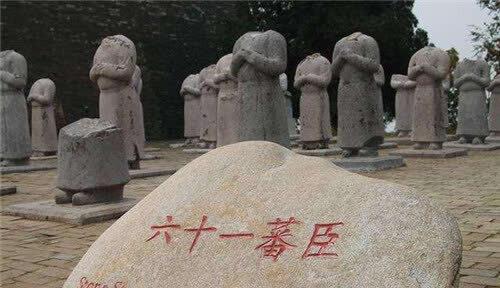Located in qianxian county of Xianyang City, Shaanxi Province, there is a mausoleum called Qianling, located on the top of Liangshan in Qianxian County, Shaanxi Province is the mausoleum site of Wu Zetian and Tang Gaozong Li Zhi, and there are 61 headless terracotta warriors on both sides of the east and west sides of the Suzaku Gate of the cemetery, in fact, if it is a complete terracotta warriors, it is better to say, but the figurines without heads stand in front, very strange, and even the local specially invited archaeological team, but after research and investigation, they found nothing, so that archaeologists are also very difficult, fruitless, and then can only be lost.

The arrangement of the 61 headless terracotta warriors on the east and west sides outside the Suzaku Gate of this cemetery is 29 and 32 respectively, which is similar to the terracotta warriors of Qin Shi Huang in that year, the difference is that the identity of the figurines in front of Wu Zetian's tomb may be much higher than the status and status of the terracotta warriors in front of the mausoleum of Qin Shi Huang. According to the costumes of the time and the records in the "Tongzhi of Shaanxi", these figurines before Wu Zetian should be the leaders of a small number of famous clans or envoys.
According to zhao Kai's "Qianling Map", it is also recorded: "The burial of Qianling is also a lot of helpers from all the people. Empress Wu did not know that Emperor Taizong's mighty legacy was exaggerating in the afterlife, so he recorded sixty-one of his chiefs, each of whom was in his form, engraved in his form, and made it known to future generations."
Empress Wu did not even know about Emperor Taizong's legacy, so she wanted to exaggerate and show off the future generations, so she recorded sixty-one of their chiefs, each like its shape, carved with a dragon, hoping to make it known to later generations. And these headless terracotta warriors have always been considered by the locals to be the leaders of a small number of famous tribes, but in fact, according to the discoveries of archaeologists, the identity is far from so simple.
The explanation given is that, first, but from the point of view of clothing, most of the costumes worn by these terracotta warriors are left samurai robes with round necks and tight sleeves, which is the most prominent symbol of distinguishing the Han and Hu people, and should be the identity of ethnic minorities. Second, these terracotta warriors held wat plates in their hands, similar to the folds in the hands of ancient ministers, which were used as tools for reporting during the dynasty.
Finally, it was also found that more than twenty of the terracotta warriors were also equipped with jade bags around their waists, if according to the regulations of the Tang Dynasty, only officials with more than five pins were eligible to wear such jade bags, through the analysis of experts, it was judged that these terracotta warriors should be officials during the Tang Dynasty. But after the identity is determined, how should these terracotta warriors have no heads? Especially in ancient times, such an asymmetrical placement was very contrary to an aesthetic layout at that time, and experts were very confused about it.
The time came to a turnaround in the late autumn of 1971. By chance. When two old farmers in Guaboling Village, Qianxian County, Shaanxi Province, were working in the fields, they found that their hoes seemed to have touched something hard, and when the peasants dug it open, it turned out to be a head, and the head was exquisitely carved in stone, which made the two peasants at that time very surprised, and they hurriedly reported it to the village organization, and then identified by the experts in the county cultural management committee, and the experts knew at a glance that this was the head of the terracotta warriors in front of Wu Zetian's tomb.
Of course, before about the origin of these 61 heads, the people are also controversial, there are rumors that these terracotta warriors will turn into monsters at night, stealing the grain planted by the villagers, the villagers can't help but panic, so they gathered the public to smash the heads. There is also a saying that when the Eight-Power Alliance invaded, when he saw the heads of foreign envoys in front of the tomb, he thought that this was an insult to them, so he smashed it.
But this argument is naturally untenable, after all, how could the Eight-Nation Alliance have not been to Qianxian in those years and smash the head? According to the historical data consulted by experts, the reason why the head was removed is most likely related to the earthquake that occurred in Guanzhong on January 23, 1555. Qianling is also in the earthquake area, the stone statue has light lines everywhere, the stone is likely to be flawed, and the neck is just a fragile and easy to bend part, which is very easy to break in the earthquake.
Therefore, the heads of the 61 stone statues are very likely to be shaken off due to the earthquake, and later experts found 3 semi-unfinished stone statues nearby, which is exactly 64 with the previous 61 statues, which is in line with the symmetrical distribution. Therefore, experts conclude that the heads of the 61 stone statues were indeed destroyed in the earthquake, and of course, it is not excluded that they were destroyed in repeated wars in the late Ming and early Qing dynasties.